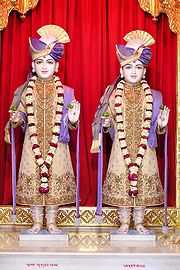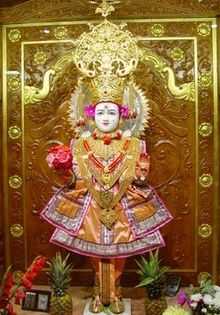Swaminarayan Hinduism
Swaminarayan Hinduism, also known as the Swaminarayan faith or the Swaminarayan sect, is a modern tradition in the state of Gujarat, in which followers offer devotion to and worship Swaminarayan. The Swaminarayan faith has a large percentage of Gujarati Hindus who are followers of Swaminarayan.[1]
Beliefs
Considered a Vaishnava Bhakti sect following philosophical teachings of Uddhav as per Ramanujacharya. Since its origin, Swaminarayan Hinduism has been noted by its preservation of Gujarati cultural and linguistic traditions, devotion to the personality of Swaminarayan as supreme deity and the reason of all avtārs, dedication to social service and a strict ethical code including uncompromising segregation of the genders.[2] Monier Williams, on at least one of his visits, had long discussions with Swaminarayan and his followers and did his best to ascertain the way Swaminarayan's principles were preached.[3] He visited the temple in Vadtal in the company of the Collector of Karira during a popular Kartik Purnima festival that took place there and recorded the basics. Those who are initiated into proper worship of Krishna deity are instructed to wear a Tulasi kanti or rosary beads in two rows around their necks, one for Krishna and one for Radha. Followers are also instructed to chant the mantra of śrī-kṛṣṇa smaraṇaṁ mama (great Krishna is my soul's refuge) and wear Urdhva Pundra Tilak markings on their forehead. Daily worship of Krishna in the temple was instructed and the Krishna mantra was central to the Swaminarayan's initiation (diksa). Supreme Being is believed to be referred by various names: Para Brahman, Bhagavan and Purushottama.[3] While no detailed statistical information is available, most of the followers of Swaminarayan share a belief that Swaminarayan is the complete manifestation of Narayana or the supreme person and more superior to other avatars.[4]
Swaminarayan teachings are sometimes categorized as monotheism. It is not, however, the monotheism of Abrahamic religions. Unlike most other Vaishnavite schools such as those of Ramanuja, Madhva and Chaitanya, Swaminarayan, although leaning in preference towards Vishnu/Krishna, did not differentiate between Vishnu and Shiva; moreover, he followed a Smarta approach (scripture-sanctioned deities are viewed as different manifestations of the same Brahman) by instructing his followers to venerate all five deities of the Panchayatana puja with equal reverence.[5][6][7] Verse 84 of Shikshapatri, a key scripture to all followers of the Swaminarayan faith, makes reference to the Smarta-like belief.[8][9] In making no distinction between Vishnu and Shiva, Swaminarayan, held that Vishnu and Shiva are different aspects of the same God, instead of according Shiva a lower status as Madhva and Ramanuja had done, for example.[6][10] Verse 47 of the Shikshapatri, makes reference to this belief.[11][12]
Manifestation of Narayana

Followers of Swaminarayan believe that it was events that took place at Badarikashram, the abode of Nara Narayana, that led to the incarnation of Swaminarayan. It is believed that Narayana took birth as Swaminarayan due to a curse of sage Durvasa which he accepted at his own will. The curse led to Narayana taking the form of an avatar on Earth to destroy evil and establish ekantik-dharma, religion based on morality, knowledge, detachment and devotion.[13] Important Hindu scriptures such as the Bhagavad Gita and Bhagavata Purana confirm that Narayana descends in human form to destroy evil though there is no direct reference to Swaminarayan. He was a human & then a sage or philosopher. Only the Swaminarayan followers specifically interpret the Visvaksena Samhita, 11th part of the Brahma Purana, as well as the Skanda Purana as giving a direct reference to Narayana taking birth in the form of Swaminarayan.[14][15] None of the Puranas even mention "Swaminarayan". In the liturgy of the sect, the story of the announcement of the coming birth of Krishna in the Bhagavata Purana is similar to the story of the birth of Swaminarayan, and merging of the images and stories of Swaminarayan and Krishna has occurred. Also there how can there be incarnation of God in Kalyuga except Kalkai ? Some people believe him to be reincarnation of lord Krishna , which is not that much correct. Krishna promised to come back in Govardhans & he did in form of Shreenathji.Hence stating Swami Narayan as God won't be that much correct instead of that let him be a philosopher & a preacher who changed evil times of human by his preachings. Also he never stated that he was a god.[4] In Vaishnava theology Uddhava, who is considered to be the chief disciple of Krishna, was ordained to spread his message in a future birth, and some groups of Swaminarayan Faith believe that he reappeared as Ramananda Swami to prepare the way for another manifestation of Krishna.[16][17] Swaminarayan is said to have intimated that he was a manifestation of God Supreme in a meeting with the Reginald Heber, the Lord Bishop of Calcutta, in 1825.[18]
Fundamentals of the Swaminarayan philosophy

The basic principle of the philosophy of Swaminarayan is vishistadvaita (qualified non-dualism) as propounded by Ramanujacharya.[19][20][21][22]
- Dharma (religion): Proper conduct as defined in the revealed scriptures: 'Srutis' and 'Smritis'.[23]
- Bhakti (devotion): Supreme love of soul combined in the consciousness of the glory of the Supreme God.[24]
- Jnāna (enlightenment): Awareness of the concepts of the soul, illusion, and God.[21]
- Vairagya (renunciation): Detachment from all material possessions and absolute attachment towards God - known as 'Vairagya'.[25]
- Māyā (illusion): Named 'tri-gunatmika' i.e. illusion prevalence in three qualities of sattva, rajas and tamas; To be possessed by māyā is considered to be caught in darkness; God is the lord of māyā; It breeds ego in one for his body and for the relatives of the body.[21]
- Mukti - (liberation or moksa): Loving worship of God.[21]
- Ātman - (self): Recognition of the ātman, after which one experiences a transcendental bliss, is achieved through bhakti yoga as outlined in the Bhagavad gita, according to the teachings of Swaminarayan. It is the source of energy and is the real knower; It pervades the entire body and is the essence that differentiates matter and life; in character it is inseparable, impenetrable, indestructible and immortal.[21]
- Paramātman - (Supreme Soul): It is omnipresent within the souls, just as soul is present in the body; it is independent and is the one who rewards the phala (fruits of karma) to the souls. It is the source of infinite material universes and the First Cause. It has no prior causes, and is the inherent cause of all effects (i.e. law of causality or karma).[21]
Some did not understand and rebel against the notion of Swaminarayan's worship of Krishna while Swaminarayan also considered himself to be a manifestation of God.[26] It is believed by his followers that just as Krishna assumed as many forms as the number of divine maidens (gopis) with whom he danced, he may have manifested himself simultaneously in many forms.[27]
Succession of Swaminarayan
Prior to his death, Sahajanand Swami decided to establish a line of acharyas, or preceptors as his spiritual successors.[28] After his death several divisions occurred with different understandings of the succession of leadership.
Swaminarayan Sampraday

Swaminarayan established two gadis (seats of leadership). One seat was established in Ahmedabad (Nar Narayan Dev Gadi) and the other one in Vadtal (Laxmi Narayan Dev Gadi) on November 21, 1825. He appointed an acharya to each of these two gadis to pass on his message to others and to preserve his fellowship, Swaminarayan Sampraday. These acharyas came from his immediate family; he formally adopted a son from each of his two brothers, Rampratap and Ichcharam, and appointed them to the office of acharya. Ayodhyaprasad, son of his elder brother Rampratap, was appointed acharya of Ahmedabad Gadi, and Raghuvira, son of his younger brother Ichcharam, was appointed acharya of the Vadtal Gadi. Swaminarayan decreed that the office should be hereditary so that acharyas would maintain a direct line of blood descent from his family.[29] The administrative division of his followers into two territorial dioceses is set forth in minute detail in a document written by Swaminarayan called Desh Vibhaag Lekh.[30] The current acharyas of the Swaminarayan Sampraday are Koshalendraprasad Pande, of the Ahmedabad Gadi, and Rakeshprasad Pande, of the Vadtal Gadi.[31][32]
After his death several divisions occurred with different understandings of the succession of leadership. Apart from this, there has been some conflicts in the Sampraday itself. Controversy over Vadtal gadi had attracted attention of national media in the past.[33][34] Besides these the sects has produced a number of schismatic groups.[35]
Bochasanwasi Shri Akshar Purushottam Swaminarayan Sanstha

Bochasanwasi Shri Akshar Purushottam Swaminarayan Sanstha (BAPS) followers hold Gunatitanand Swami as the spiritual successor to Swaminarayan. Members of BAPS assert that on several occasions Swaminarayan revealed to devotees that Gunatitanand Swami was Aksharbrahm manifest. These instances claimed by the devotees of BAPS have come to embody the philosophy known as Akshar Purushottam Upasana. It was in 1906 that a prominent ascetic named Shastri Yagnapurushdas separated from the parent organization and established this institution, claiming Gunatitanand Swami as the rightful successor.[36] Yagnapurushdas, who formed the schism, is believed by the devotees of BAPS to be the third spiritual successor of Swaminarayan; he left the Vadtal Gadi of the Swaminarayan Sampraday and was later legally excommunicated from the Vadtal Gadi.[37] The current leader of BAPS is Shastri Narayanswarupdas, more commonly known as Pramukh Swami.[38]
At the time of legal dispute between Akshar Purushottam group and the Swaminarayan Sampraday the judge summarized his understanding of the root of the schism. He confirms that the "new group, now known as BAPS, "they have put Sahajanand Swami, an ascetic, over Shri Krishna, who admittedly enjoyed the pleasures of human beings. That is why the sect has set aside Goloka as the supreme heaven, because there Krishna is supposed to be enjoying himself with his gopis. This is I think one of the fundamental differences between the two sects and the schism cannot be bridged." BAPS found these statements blasphemous.[39]
Shree Swaminarayan Gadi Sansthan
The followers of the Shree Swaminarayan Gadi Sansthan believe that Gopalanand Swami was the spiritual successor to Swaminarayan. This difference in belief of succession led to the creation of Swaminarayan Gadi in 1941.[40] The current leader of the Swaminarayan Gadi is Acharya Purushottampriyadas.[41]
The divine lustrous throne upon which Swaminarayan is seated in Akshardham (the divine abode of Swaminarayan) is Shree Swaminarayan Gadi. Shree Swaminarayan Gadi embodies the power, supremacy and sovereignty of Swaminarayan. Swaminarayan is supreme, unique, unparalleled and eternal. Thus the Gadi of Swaminarayan is also supreme, unique, unparalleled and eternal. The two are synonymous. Thus, just as the glory of Swaminarayan is infinite, the glory of Shree Swaminarayan Gadi is also infinite.
Other
A groups that claim successorship and split from the BAPS sect is the Gunatit Samaj. They consist of four factions. The founders of the Gunatit Samaj are Dadubhai Patel also known as Kakaji Maharaj and his brother Babubhai Patel known by his followers as Pappashri who were excommunicated by BAPS. They established a society organised into four different groups for different practices - The Santos, Benos, Yuvakos and The Gruhasto. The Gunatit Samaj was made due to the establishment of Gunatit Jyot, A spiritual Ashram in Vallabh Vidyanagar as per to the wishes of many of the present day leaders of the Gunatit Samaj and stones of the ashram here laid by former BAPS spiritual head Yogiji Maharaj. The women's wing from 1966 was coordinated by Pappaji until his passing in 2006 and since then the santos wing is led by Hariprasad Swami by the name of Yogi Divine Society in Sokahada. Additionally, Aksharvihari Swami leads the group in Sankarda and many other santos have establishments amongst India. The Yuvakos or Dedicated brothers is currently being led by Jashbhai Saheb or Saheb known as Anoopam Mission and the The Gruhasto wing of the Samaj is in each and everyone of the Gunatit Samaj' establishments spread amongst the worlds[42] Another group is the Swaminarayan Mandir Vasna Sanstha (SMVS). The group's founder is Devnandandas Swami.[43]
Notes
- ↑ Werbner, P. (2003). "Multiculturalism and minority religions in Britain. Krishna consciousness, religious freedom and the politics of location. By Malory Nye. Richmond: Curzon Press. 2001. xii+ 331 pp. Hb.:$ 75.00. ISBN 0-7007-1392-1.". Social Anthropology 10 (03): 395–399. doi:10.1017/S0964028202210253.
- ↑ Rudert, A. "eCommons@Cornell: Inherent Faith and Negotiated Power: Swaminarayan Women in the United States". ecommons.cornell.edu. Retrieved 2009-05-10. Chapter 1. (2004)
- ↑ 3.0 3.1 S Golwalkar (1997). "Swaminarayan, Pramod Mahajan, Bal Thackeray". In M. G. Chitkara. Hindutva. APH Pub. Corp. p. 228. ISBN 81-7024-798-5.
He is then given the sacred formula, Sri Krishna tvam mama
- ↑ 4.0 4.1 Williams 2001, p. 77
- ↑ An Introduction to Swaminarayan Hinduism, by Raymond Brady Williams at http://books.google.com/books?id=tPkexi2EhAIC&pg=PA25&dq=Shikshapatri+Vishnu+shiva&lr=&cd=1#v=onepage&q=Shikshapatri%20Vishnu%20shiva&f=false
- ↑ 6.0 6.1 Encyclopedia of Hinduism, article by B.N. Krishnamurti, pgs. 67-68 at http://books.google.com/books?id=UG9-HZ5icQ4C&pg=PA67&lpg=PA67&dq=shiva+madhva+hierarchy&source=bl&ots=dq2q07HLTy&sig=EjbwE8szalkDKB7zF_At4zr09Qs&hl=en&ei=7ErvS4m8IoT7lwfgjvm0CA&sa=X&oi=book_result&ct=result&resnum=9&ved=0CD0Q6AEwCA#v=onepage&q&f=false
- ↑ The Teachings of Lord Chaitanya, Chapter 8: The Avataras Author: A. C. Bhaktivedanta Swami Prabhupada
- ↑ Swaminarayan Satsang - Scriptures
- ↑ Swaminarayan Satsang - Scriptures
- ↑ According to this site, http://www.kakaji.org/shikshapatri_verses.asp?catid=viewAll], verses 47, 84, of their scripture, Shikshapatri, a key scripture to all followers of the Swaminarayan faith. states, "And the oneness of Narayana and Shiva should be understood, as the Vedas have described both to be brahmaroopa, or form of Brahman, i.e., Saguna Brahman, indicating that Vishnu and Shiva are different forms of the one and same God.
- ↑ Swaminarayan Satsang - Scriptures
- ↑ Swaminarayan Satsang - Scriptures
- ↑ "History of Incarnation of Lord Shree Swaminarayan".
- ↑ "Lord Swaminarayan".
- ↑ M. G. Chitkara (1997). Hindutva. APH. p. 232. Retrieved June 13, 2009.
- ↑ Williams 2001, p. 16
- ↑ "Lord Swaminarayan - Description of the Sampraday".
- ↑ Raymond Brady Williams (2004). Williams on South Asian Religions and Immigration: Collected Works. Ashgate Publishing Ltd. p. 81. ISBN 0-7546-3856-1.
- ↑ Dinkar Joshi, Yogesh Patel (2005). Glimpses of Indian Culture. Star Publications. pp. 92–93. Retrieved May 7, 2009.
- ↑ Williams 2001, p. 14
- ↑ 21.0 21.1 21.2 21.3 21.4 21.5 "Vishistadvaita, The philosophy of the Swaminarayan Sect".
- ↑ "Ramanujacharya".
- ↑ M. G. Chitkara (1997). Hindutva. APH. p. 230. Retrieved May 5, 2009.
- ↑ Martha Craven Nussbaum (2007). The clash within. Harvard University Press. Retrieved May 5, 2009. Page 322, 323
- ↑ Behramji Merwanji Malabari, Krishnalal M. Jhaveri, Malabari M. B (1997). Gujarat and the Gujaratis. Asian Educational Services. pp. 263–269. ISBN 81-206-0651-5. Retrieved May 7, 2009.
- ↑ Williams 2001, p. 70
- ↑ Williams 2001, p. 73
- ↑ Williams 2001, pp. 34
- ↑ Williams 2001, pp. 35
- ↑ Williams 2001, pp. 36
- ↑ "Times Music cassette on Swaminarayan serial launched". Times of India. 2006-01-19. Retrieved 2009-03-30.
- ↑ "Vadtal, the delinquent in Swaminarayan family". Times of India. 2003-03-17. Retrieved 2009-03-30.
- ↑ "Sex, swamis and a CD: Scandal sparks off row". www.expressindia.com. Retrieved 2009-05-23.
- ↑ "Swaminarayan monks caught in sex video - India - The Times of India". indiatimes.com. Retrieved 2009-05-23.
- ↑ "Niche Faiths". Indian Express. 2007-05-26. Retrieved 2009-05-06.
- ↑ The camphor flame: popular Hinduism and society in India. Princeton, N.J: Princeton University Press. 2004. p. 172. ISBN 0-691-12048-X.
- ↑ Williams 2001, p. 54
- ↑ Williams 2001, p. 87
- ↑ Williams 2001, p. 59
- ↑ Shree Swaminarayan Gadi Sansthan. "Shree Swaminarayan Gadi Historical Timeline". swaminarayangadi.com. Retrieved 2014-01-27.
- ↑ Williams 2001, p. 52
- ↑ "Kakaji - International Spiritual Research Center".
- ↑ Williams 2001, p. 68
References
- Williams, Raymond (2001), Introduction to Swaminarayan Hinduism, Cambridge University Press, ISBN 978-0-521-65422-7
| |||||||||||||||||||||||||||||||||||||||||||||||||||||||||||||||||||||||||||||||||||||||||||||||||||||||



.jpg)